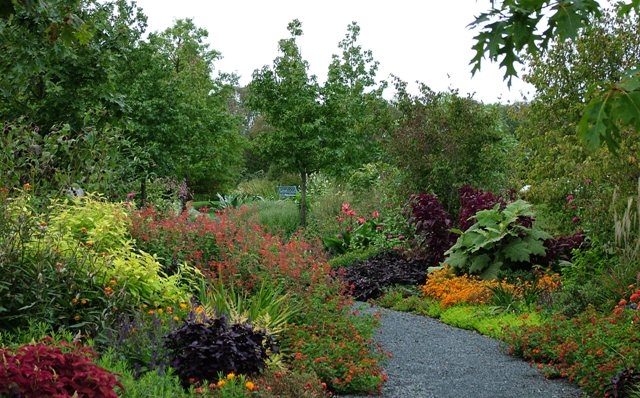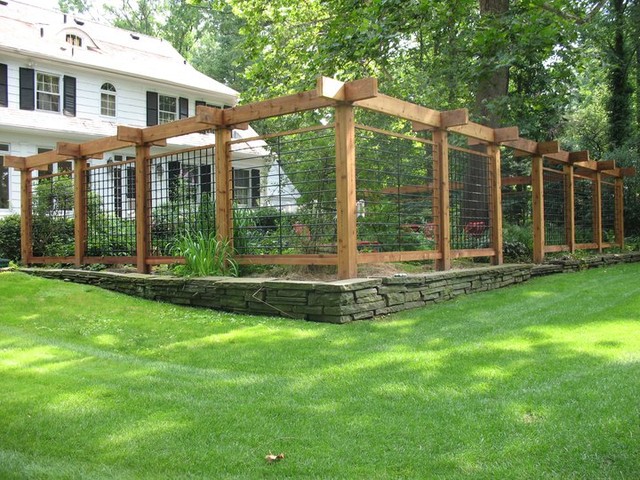Raised Garden Bed With Deer Fence Plans can be found on various websites offering free project plans and step-by-step instructions for building a deer-proof garden fence around raised beds. These plans typically use wood, chicken wire, and deer netting to create an enclosed and secure garden space.
Some popular options include using levels for proper installation, adding gate supports and anchoring, and even incorporating electric fences to protect against deer. It is important to build the wall at a height that will prevent jumping and to consider using streamers or warning signs to deter deer from running through.

Credit: www.homedepot.com
Introduction To Deer-proof Gardening
Deer can be one of the biggest challenges faced by gardeners. These graceful creatures can easily wreak havoc on your precious plants and flowers, leaving behind a trail of destruction. However, with the right strategies and tools, you can protect your garden from the unwanted attention of deer and enjoy a lush and thriving garden all year round. One effective solution to keep deer at bay is incorporating raised garden beds with deer fence plans. In this article, we’ll explore the understanding of the challenges of deer in the garden, the benefits of raised garden beds with deer fences, and different types of deer-proof garden bed designs.
Understanding The Challenges Of Deer In The Garden
Deer are notorious for their voracious appetites, and they have a particular love for tender and tasty plants. These animals can quickly decimate a garden, leaving homeowners frustrated and disappointed. Understanding the challenges of deer in the garden is the first step in implementing effective deer-proofing strategies.
Benefits Of Raised Garden Beds With Deer Fence
Raised garden beds with deer fences offer numerous benefits when protecting your garden from deer. Not only do they create physical barriers that make it difficult for deer to access your plants, but they also provide additional advantages for your gardening endeavours. Some of these benefits include:
- Better plant growth and drainage due to improved soil conditions in raised garden beds
- Protection from other garden pests, such as rabbits and groundhogs
- Easy accessibility for gardening tasks, such as planting, weeding, and harvesting
- Extended growing season, as raised garden beds tend to warm up faster in spring and retain heat longer in the fall
Different Types Of Deer-proof Garden Bed Designs
When it comes to designing deer-proof garden beds, there are various options. Each design has advantages and considerations, depending on your needs and preferences. Here are some popular deer-proof garden bed designs:
| Design | Description |
|---|---|
| Enclosed Garden Bed | An enclosed garden bed is fully covered with a deer-proof fence or netting, creating a secure space for your plants. |
| Planter Box with Deer Fence | A planter box is elevated from the ground and surrounded by a deer fence, offering protection without digging. |
| DIY Raised Garden Bed | Building your raised garden bed allows you to customize the size and materials while incorporating a deer fence. |
These are a few examples of the many deer-proof garden bed designs available. Depending on your budget, gardening space, and aesthetic preferences, you can find the perfect solution to keep deer away from your plants.

Credit: www.jannelsonlandscapedesign.com
Designing And Building A Deer-proof Raised Garden Bed
Easily build a deer-proof raised garden bed using our detailed plans. Protect your plants and vegetables from deer damage with a secure deer fence around your raised garden bed.
Choosing The Right Materials For A Deer-proof Garden Bed
When designing and building a raised deer-proof garden bed, choosing the right materials is crucial to determining the durability and effectiveness of your deer fence. Here are some essential materials you should consider:
- Durable Wood: Opt for rot-resistant wood such as cedar or redwood for the garden bed frame. These types of wood can withstand outdoor conditions and provide a sturdy foundation for your raised bed.
- Metal Fence Posts: You’ll need sturdy metal fence posts to support the deer fence. Choose posts made from galvanized steel or another durable material to ensure they withstand the test of time.
- Deer-Resistant Netting: Look for high-quality deer-resistant netting strong enough to withstand pressure. The netting should have small enough gaps to prevent deer from accessing your garden bed.
- Zip Ties or Wire: Use zip ties or wire to securely attach the netting to the fence posts. Ensure the attachments are tight to prevent gaps that could allow deer to sneak in.
Step-by-step Guide To Building A Deer-proof Raised Garden Bed
If you’re ready to embark on the journey of building your own deer-proof raised garden bed, follow these straightforward steps:
- Please choose a Location: Select a suitable location for your garden bed, ensuring it receives ample sunlight and is easily accessible.
- Prepare the Ground: Clear the area of any weeds, grass, or other vegetation. Level the ground to create a stable foundation for your raised bed.
- Build the Frame: Assemble the garden bed frame using durable wood and screws. Make sure the frame is sturdy and level.
- Add Protective Measures: Attach deer-resistant netting to the frame using zip ties or wire. Ensure all sides are covered and there are no gaps for deer to enter.
- Install Fence Posts: Drive metal fence posts into the ground at the corners and intervals along the garden bed. Ensure the posts are secure and stable.
- Attach Netting to Posts: Securely attach the netting to the fence posts using zip ties or wire. Make sure the netting is tight and free of any gaps.
- Test the Fence: Walk around the perimeter of your deer-proof garden bed to ensure there are no loose spots or areas where deer can enter.
Installing Deer fences and Other Protective Measures
Building a deer-proof raised garden bed involves more than just installing the fence. There are a few additional protective measures you can take to ensure your garden stays deer-free:
- Electric Fence: Add an electric fence to deter deer from approaching your garden. This can be an effective method to keep deer at bay.
- Plant Deer-Resistant Plants: Choose plants that deer are less likely to eat. Research deer-resistant plants that thrive in your area and incorporate them into your garden bed.
- Natural Deterrents: Use natural deterrents such as hanging aluminium foil strips, human hair, or soap pieces around the garden area. These odours and reflective materials can repel deer.
- Motion-Activated Sprinklers: Install motion-activated sprinklers around your garden bed. When deer approach, the sprinklers will trigger, startling and deterring the deer.
By following these steps and implementing the right materials and protective measures, you can create a deer-proof raised garden bed that allows you to enjoy gardening without worrying about deer damage.
Maintaining And Protecting Your Deer-proof Garden Bed
Protecting and maintaining your deer-proof garden bed is crucial for a successful gardening experience. Using a raised garden bed with deer fence plans, you can create a sturdy, enclosed space that keeps pesky deer away from your plants, ensuring their safety and growth.
Practical Tips For Keeping Deer Away From The Garden
When it comes to maintaining and protecting your deer-proof garden bed, there are practical tips you can follow to keep these pesky creatures away. Here are some effective methods:
- Use a physical barrier like a fence or netting to keep deer out of your garden. Please ensure the wall is at least 8 feet high and extends 6 inches below ground to prevent them from jumping or digging under it.
- Plant deer-resistant plants that are unpalatable to these animals. Some examples include lavender, sage, and marigolds.
- Apply natural deterrents like blood meal, garlic spray, or hair clippings around the garden bed. The strong smell will deter deer from entering.
- Install motion-activated sprinklers that will startle deer when they approach. The sudden burst of water will discourage them from coming back.
- Regularly inspect the garden bed for any signs of deer activity and address them promptly. This includes repairing any damage to the fence or adding additional deterrents if necessary.
Preventing Other Garden Pests And Wildlife Damage
While deer may be the primary concern for gardeners, there are other pests and wildlife that can also cause damage to your plants. Here are some preventive measures you can take:
- Use organic pest control methods like companion planting and insect-repelling herbs to deter common garden pests such as aphids, slugs, and snails.
- Keep your garden bed clean and free of debris that can attract pests. Regularly remove fallen leaves, weeds, and dead plants.
- Inspect your plants regularly for signs of pest infestation or disease. Early detection can help prevent the spread of problems.
- Use row covers or bird netting to protect your plants from birds, rabbits, and squirrels.
- Encourage natural predators like ladybugs and birds that feed on pests to make your garden their home.
Ensuring Longevity And Success Of Your Deer-proof Garden
To ensure the longevity and success of your deer-proof garden bed, here are some additional tips to keep in mind:
- Properly prepare the soil before planting. Use organic compost and ensure good drainage to promote healthy plant growth.
- Water your garden bed consistently, considering each plant’s specific watering needs.
- Maintain a regular pruning schedule to keep your plants in optimal shape and prevent overcrowding.
- Fertilize your plants with organic, slow-release fertilizers to give them essential nutrients throughout the growing season.
- Monitor the weather conditions and adjust your gardening practices accordingly. Protect your plants from extreme temperatures, frost, and heavy rainfall when necessary.
- Keep a garden journal to track the progress of your plants, note any issues or successes, and learn from your experiences.

Credit: www.houzz.com
Frequently Asked Questions For Raised Garden Bed With Deer Fence Plans
How High Should A Deer Fence Be Around A Garden?
A deer fence around a garden should be at least 8 feet high to keep deer out. Deer netting or wire fencing can be effective, but ensure it is installed on sturdy posts and at the right height to prevent jumping.
How Do I Make My Garden Fence Deer Proof?
Use deer netting or wire fencing installed on sturdy metal posts to make your garden fence deer-proof. Add streamers to warn deer and prevent them from running through. Make sure the wall is at a height that prevents jumping.
What Is The Minimum Height For A Fence To Keep Deer Out?
The minimum height for a fence to keep deer out is typically 8 feet. Deer netting or wire fencing installed on sturdy posts can help prevent them from jumping over. Using streamers can also deter deer from running through the fence.
What Kind Of Fence Keeps Deer Out Of A Garden?
A deer netting or wire fence installed at a height that prevents jumping can keep deer out of a garden. Adding streamers to the wall can also deter deer from running through.
Conclusion
Consider building raised garden beds with deer fence plans to protect your garden from deer and other animals. These plans provide a practical solution to keep wildlife out and ensure the safety of your plants. Using materials such as chicken wire and sturdy metal posts, you can create a sturdy and effective barrier.
You can enjoy a beautiful garden without worrying about animal damage with the right design and construction. So, get started on your project and enjoy the benefits of a deer-proof garden.

